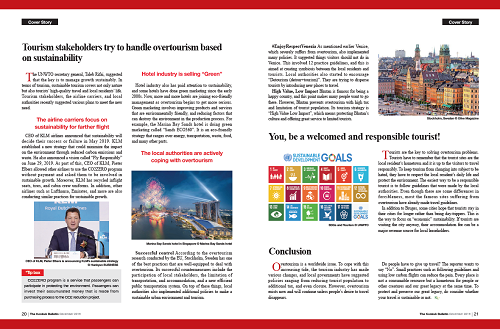
|
Venice, Galapagos Islands, Dubai, Paris, Jeju Island, and Bali
What is the first thing that popped into your head when you see these words? You would have thought that you want to visit there someday. However, the affection people have for these places can be somebody’s tragedy. According to the United Nations World Tourism Organization (UNWTO), there were 1.4 billion international arrivals in 2018, and the number will increase to 1.8 billion in 2030. The huge number of tourists has caused a big tide: Overtourism.
Everyday, tourists pour into famous destinations, and it resulted in overtourism. Overtourism has successively created communitywide problems just like a ticking time bomb. Too many visitors have destroyed nature, culture, and cultural legacy. Moreover, they have simultaneously lowered the quality of tourists’ experiences and the local residents’ lives. The Konkuk Bulletin analyzed some problems that overtourism has caused, and figured out how stakeholders cope with these problems. In addition, the article suggests what individual tourists can do for sustainable tourism.
What is overtourism?
Overtourism is a compound word of “over” and “tourism”. It means that an uncontrollable number of tourists visiting tourist attractions overwhelm local residents, but there is no strict standard of “uncontrollable”. To cite several lines from Responsible Travel website, overtourism occurs when rent prices push out local tenants to make way for holiday rentals, when narrow roads become jammed with tourist vehicles, when tourists cannot see landmarks because of the crowds, and so on.
Overtourism began to emerge as a global issue after largescale protests over tourists occurred in Barcelona, Spain in July 2017. Nowadays, many stakeholders are paying attention to overtourism. It has negative effects not only on the natural environment but also the local economy, traditional culture, and local residents’ life. Overtourism, however, is still on the first policy-cycle stage of agenda setting. It is not the problem only in Barcelona or a few other places anymore. Many famous tourist sites such as Iceland, Peru, and so on also suffer from overtourism. In Korea, three regions: Seoul, Busan, and Jeju Island, are also involved. Nevertheless, Gyeonggi Research Institute reported that 62.3 percent of 1,000 Koreans being interviewed have not even heard about overtourism.
The negative impacts of overtourism
ENVIRONMENTAL_
“I will close Boracay. Boracay is a cesspool,”
by Philippines President Rodrigo Duterte (2019.03.09)
Environmental pollution is a major problem of overtourism. Some irresponsible tourists contaminate water, soil, and air. World famous sites are becoming a cesspool because tourists discharge huge amount of filthy water and garbage.
In particular, Boracay in the Philippines has become a typical example after Duterte had it closed because of environmental pollution caused by tourists last year. Tourists from all over the world gathered in Boracay to see the beautiful ocean and white beach. The visitors, on average, threw away total 115 tons of garbage per day, and only 30 tons of them were picked up. As a result, President Duterte closed Boracay and conducted an environmental rehabilitation for six months last year, and made new regulations about the number of visitor and hotel accommodations.
Although the Philippines government seriously warned tourists with regard to environmental destruction, some tourists still ignore regulations and keep their thoughtless behaviors. For example, a Chinese tourist buried a baby’s soiled diaper in the Boracay beach, so one part of beach was closed again for three days in August 2019. Recently, police in The Philippines arrested a Korean tourist who urinated on the Boracay beach in September 2019.
CULTURAL_
Is Jeonju theme park only for tourists?
Many people expect to feel the unique mood of a place when they plan to travel to a new country. In Korea, Jeonju Hanok1) Village would be a perfect site to feel the traditional Korean mood. Many foreigners, who often wear traditional Korean garments known as Hanbok, are easily found in the village. Jeonju authorities have bought traditional Hanoks and established various cultural facilities for tourists since 2003. They also established tourism infrastructures from 2000 to 2008, and 11 million people visited Hanok Village in 2017. Moreover, Jeonju was authorized as a creative city by UNESCO and gained more popularity.
It is definitely true that Jeonju Hanok Village arouses tourists’ interest in Korean traditions. However, Jeonju Hanok Village, now, seems to be focusing less on tradition and more on commercial purposes. When Jeonju city made plans for making Jeonju Hanok Village tourist destination, it did not make specific regulations regarding building new Hanoks. Therefore, there are strange-styled Hanoks such as a modern building with traditional Korean roof tiles in the village.
Hanok Village has played a role as a residential area since the 1930s. More and more people travel to Jeonju, and it has become more like a well-decorated theme park. Hanok Village might be worthy of tourism only when it is a place that can show well-preserved tradition. In terms of changes only for tourists and modified traditions, Jeonju city has to devise a better way to preserve tradition and prevent the excessive commercialization.
SOCIAL & ECONOMIC_
Touristification2): We do not want tourists anymore!
“Tourists Go Away!”
The Venice anti-tourism protest slogan
People who live in Venice, also known as the “city of water”, suffer from an enormous number of tourists. Approximately 25 million tourists pour into Venice each year and occupy most parts of the city. Consequently, Venice has become a typical example of touristification along with Barcelona, Spain. The Venetian have held anti-tourist demonstrations since 2012. They launched boats on the canal and ocean to protest against large cruise ships in 2013, and these kinds of demonstrations have continued until now.
Venetians who cannot afford the soaring prices have been leaving their hometown since the 1960s. Today there are just one third as many Venetians as 50 years ago. Residential areas have changed into a collection of luxury shops and global brands. Local citizens consistently complain about overtourism, so Venice authorities have enacted several ordinances and started to cope with overtourism. For example, Luigi Brignaro, the mayor of Venice, stated tourists in Venice will be banned from smoking outdoors from next year. He has urged the World Heritage committee of the UNESCO to put Venice on its World Heritage site blacklist to highlight the trouble that came from overtourism.
“Tourism kills the city”
The Barcelona anti-tourism protest slogan
Barcelona in Spain is a popular site to travel, and approximately 30 million people visit there every year. Tourists caused inflation in prices and destroyed the locals’ daily lives with gentrification3), noise, and so on. Residents held large-scale protests with the slogan, “Tourism kills the city” in 2017. According to Forbes, the mayor of Barcelona, Ada Colau, pledged to reduce the number of tourists allowed into the city. Local authorities implemented several policies such as additional tax, as well as hotel and bus limitations.
Tip box
The newly coined anti-tourism words
① “Tourism-phobia” as it is being coined, is the fear, aversion or social rejection that the local citizens feel in a destination towards the tourists generally due to the bad planning of tourism policies whose exploitation causes the destruction of the social fabric and tends to lead to a decrease in the local quality of life.
© Viajarseguro
② “Disneyfication” is a term which describes the transformation of something usually society at large to resemble The Walt Disney Company’s theme parks.
©Definitions
Why is overtourism happening?
Overtourism is caused by a combination of the factors, so it is hard to say that just one factor has the main role. However, there are several major factors in play: growing tourist populations, SNS platforms, and large cruise tours.
Most sightseeing cities planned strategies focused on volume growth, so more and more tourists visit the city without enough infrastructure. The development of Low Cost Carrier (LCC) and Airbnb lowered travel costs, and it also causes an increase in the number of tourists. Moreover, increased demands for flights have caused more carbon emissions that contaminate nature.
Furthermore, Generation Z4) mainly gets information from SNS such as Instagram, Facebook, and YouTube. It made it easier to select certain destinations which influencers already had visited and reviewed. Most tourism stakeholders use this feature in their marketing strategies, which can also cause viral marketing.
Tourists who use large cruise ships cause another problem. Simply put, most cruise travelers are day-trippers, and they gather in a small number of landmarks in short time and do not pay for accommodation. For example, 8.3 million tourists visited Bruges, Belgium, and 6 million among them were cruise travelers in 2017. In Bruges, they spent three hours on average. This made overtourism more serious, and local authorities announced new regulations including the reduction of cruise ships as well as stopping campaigns that encourage day-trippers.
Tourism stakeholders try to handle overtourism based on sustainability
The UNWTO secretary general, Taleb Rifai, suggested that the key is to manage growth sustainably. In terms of tourism, sustainable tourism covers not only nature
but also tourists’ high-quality travel and local residents’ life. Tourism stakeholders, the airline carriers, and local authorities recently suggested various plans to meet the new need.
The airline carriers focus on sustainability for farther flight
CEO of KLM airlines announced that sustainability will decide their success or failure in May 2019. KLM established a new strategy that could minimize the impact on the environment through reduced carbon emissions and waste. He also announced a vision called “Fly Responsibly” on June 29, 2019. As part of this, CEO of KLM, Pieter Elbers allowed other airlines to use the CO2ZERO program without payment and asked them to be involved in sustainable growth. Moreover, KLM has recycled inflight seats, tires, and cabin crew uniforms. In addition, other airlines such as Lufthansa, Emirates, and more are also conducting similar practices for sustainable growth.
Tip box
CO2ZERO program is a service that passengers can participate in protecting the environment. Passengers can invest their accumulated money that is made from purchasing process to the CO2 reduction project.
Hotel industry is selling “Green”
Hotel industry also has paid attention to sustainability, and some hotels have done green marketing since the early 2000s. Now, more and more hotels are joining eco-friendly management as overtourism begins to get more serious. Green marketing involves improving products and services that are environmentally friendly, and reducing factors that can destroy the environment in the production process. For example, the Marina Bay Sands hotel is doing green marketing called “Sands ECO360”. It is an eco-friendly strategy that ranges over energy, transportation, waste, food, and many other parts.
The local authorities are actively coping with overtourism
Successful control
According to the overtourism research conducted by the EU, Stockholm, Sweden has one of the best practices that are well-equipped to deal with overtourism. Its successful countermeasures include the participation of local stakeholders, the limitation of transportation, and accommodation, and a new efficient public transportation system. On top of these things, local authorities also implemented additional policies to make a sustainable urban environment and tourism.
#EnjoyRespectVenezia
As mentioned earlier Venice, which severely suffers from overtourism, also implemented many policies. It suggested things visitors should not do in Venice. This involved 12 practice guidelines, and this is aimed at creating symbiosis between the local residents and tourists. Local authorities also started to encourage “Detourism (detour+tourism)”. They are trying to disperse tourists by introducing new places to travel.
High Value, Low Impact
Bhutan is famous for being a happy country, and this point makes many people want to go there. However, Bhutan prevents overtourism with high tax and limitation of tourist population. Its tourism strategy is “High Value Low Impact”, which means protecting Bhutan’s culture and offering great service to limited tourists.
You, be a welcomed and responsible tourist!
Tourists are the key to solving overtourism problems. Tourists have to remember that the tourist sites are the local resident’s hometown and it is up to the visitors to travel responsibly. To keep tourism from changing into subject to be hated, they have to respect the local resident’s daily life and protect the environment. The easiest way to be a responsible tourist is to follow guidelines that were made by the local authorities. Even though there are some differences in forcibleness, most the famous sites suffering from overtourism have already made travel guidelines.
In addition to Bruges, some cities hope that tourists stay in their cities for longer rather than being day-trippers. This is the way to focus on “economic” sustainability. If tourists are visiting the city anyway, their accommodation fee can be a major revenue source for local leaseholders.
Conclusion
Overtourism is a worldwide issue. To cope with this increasing tide, the tourism industry has made various changes, and local governments have suggested policies ranging from reducing tourist population to additional tax, and even closure. However, overtourism exists now and will continue unless people’s desire to travel disappears.
Do people have to give up travel? The reporter wants to say “No”. Small practices such as following guidelines and using low carbon flights can reduce the pain. Every place is not a consumable resource but a hometown for people or other creatures and our great legacy at the same time. To protect and preserve our great legacy, do consider whether your travel is sustainable or not.
1) Korean traditional house
2) A compound word of tourism and gentrification and literally means the process of touristifying
3) The process of renovating and improving a house or district so that it conforms to middle-class taste
4) The generation of people born in mid-1990s to mid-2000s, following generation Y



